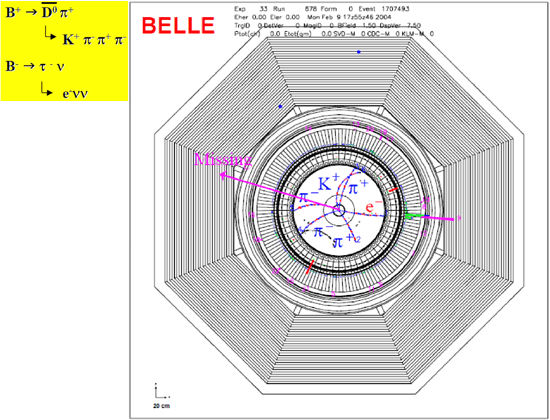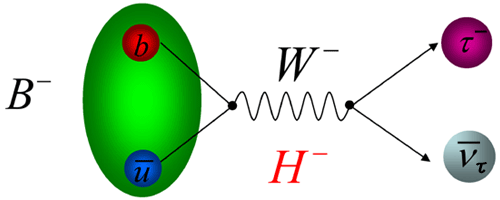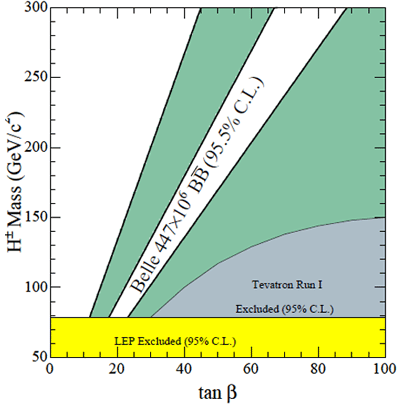The goal of the B-factory at the High Energy Accelerator Research Organization (KEK) is not only to test the Kobayashi-Maskawa theory, an ingredient of the Standard Model to explain the violation of the matter and anti-matter (CP) symmetry, but also to find effects of new particles in rare decays of the B mesons. The Belle experiment has recently revealed evidence for a rare "missing energy" decay of the B mesons for the first time, and the measurement of the decay gives a tight constraint on a hypothetical particle called "charged Higgs". The results were announced at the 33rd International Conference on High Energy Physics, being held in Moscow from July 26.
The neutrino cannot be detected in the Belle experiment because of its so weak interaction with matter, hence observed as a "missing energy". B decays accompanying neutrinos in the final state are sensitive to new particles, if they exist, therefore, have been long sought despite the difficulty in detection. The Belle experiment has succeeded to find about 17 events of B decays into the tau lepton and neutrino ( ) from the data sample containing about 450 million B meson pairs. In the ) from the data sample containing about 450 million B meson pairs. In the  decay, the B meson transforms into a final state containing only leptons. The decay is hard to find because not only it is rare but the tau lepton decays with neutrinos. The experimental breakthrough that allowed the discovery of the missing energy decay mode involved detecting all the decay products of the B meson accompanying the sought-after decay, thereby containing the energy and momentum of the missing or undetected particles. This technique has a very low efficiency and is only possible because of the unprecedented luminosity of the KEKB accelerator. decay, the B meson transforms into a final state containing only leptons. The decay is hard to find because not only it is rare but the tau lepton decays with neutrinos. The experimental breakthrough that allowed the discovery of the missing energy decay mode involved detecting all the decay products of the B meson accompanying the sought-after decay, thereby containing the energy and momentum of the missing or undetected particles. This technique has a very low efficiency and is only possible because of the unprecedented luminosity of the KEKB accelerator.
The  decay is sensitive to new particles such as the "charged Higgs ( decay is sensitive to new particles such as the "charged Higgs ( )", as predicted by Super Symmetry (SUSY), which is one of the most promising candidates of the New Physics. If )", as predicted by Super Symmetry (SUSY), which is one of the most promising candidates of the New Physics. If  exists, it couples to the tau and neutrino pair, and depending on its mass, change the branching ratio of exists, it couples to the tau and neutrino pair, and depending on its mass, change the branching ratio of  decay. The result is consistent to the Standard Model prediction within the error, and does not support the existence of decay. The result is consistent to the Standard Model prediction within the error, and does not support the existence of  . Instead, it constrains the mass region allowed for its existence, as shown in Figure 3. This detection of a rare missing-energy decay is the first step towards the observation of exotic decays such as D* . Instead, it constrains the mass region allowed for its existence, as shown in Figure 3. This detection of a rare missing-energy decay is the first step towards the observation of exotic decays such as D* (D* meson, tau and neutrino) , K* (D* meson, tau and neutrino) , K* (K* meson and two neutrinos), and other types of unusual and new physics related processes. (K* meson and two neutrinos), and other types of unusual and new physics related processes.
| |
for more details : Belle group
Media Contact :
Youhei Morita, KEK Public Relations Office, +81 29-879-6047
|
 |
Figure 1 : A typical candidate event. From the B+B- pair produced via e+e- collision, one B decays into D and the other B decays into and the other B decays into  . The . The  decays immediately and produce two neutrinos. Consequently, the event is seen associated with the "missing energy". decays immediately and produce two neutrinos. Consequently, the event is seen associated with the "missing energy". |
 |
Figure 2 : In the Standard Model, the B meson ( a bound state of b and anti-u quarks) decays into tn through intermediate weak boson (W-), as shown in this diagram. If the charged Higgs (H-) exists, as predicted by Super Symmetry, the decay could proceed also through intermediate H-, and the decay branching fraction could be changed. Therefore, measurement of  is important to search for New Physics. is important to search for New Physics. |
 |
Figure 3 : The result of the charged Higgs ( ) search. From the measured branching fraction of ) search. From the measured branching fraction of  , the region shaded by green hatch is excluded. The vertical axis represents the mass of , the region shaded by green hatch is excluded. The vertical axis represents the mass of  , the horizontal axis is a parameter related to the coupling between the , the horizontal axis is a parameter related to the coupling between the  and quarks. The constraint provided by previous experiments at LEP (CERN) and Tevatron (Fermilab) accelerators are shown by yellow and gray hatched regions, respectively. and quarks. The constraint provided by previous experiments at LEP (CERN) and Tevatron (Fermilab) accelerators are shown by yellow and gray hatched regions, respectively. |
|



